Peggy Sage
Continued onto: Peggy Sage (post 1940)
Peggy Sage was born Rosabelle or Rosella Doody in New York State in 1880. Unfortunately, a birth certificate to confirm her first name has not been found. Her parents, Michael Doody [1852-1884] and Elizabeth Doody, née Elizabeth Fitzpatrick [c.1844-1895] also appear to have been born in the United States but the Doody family was originally from Ireland.
In 1884, the family was living in Rochester, New York, when Rosabelle’s father was killed in a train accident on the West Shore & Buffalo Railroad. He was a passenger on the train, returning home from a job as a telegraph linesman. Rosabelle’s mother got a US$5,000 payout from West Shore & Buffalo but she also worked as a dressmaker to support herself and her daughter.
After her mother died in 1895, Rosabelle went to live with her uncle and aunt and their their two sons who also resided in Rochester. In the 1900 census she is listed as a shoe fitter but had switched to millinery by 1903. By 1906, she was working as a manicurist, the occupation that would engage her for the rest of her working life. By 1907, she had also moved to New York City where she would remain until her death in 1961. No newspaper appears to have posted an obituary describing her contribution to Beauty Culture.
In 1909, Rosabelle married Thomas Martin Sage [1885-1946] and became Rosabelle Sage. Thomas, a self-employed liquor merchant, retired from that business after the introduction of Prohibition in 1920. By then, Rosabelle had started her own manicure business, trading as Le Jolie Main, Inc. (The Pretty Hand), operating out of 24 East 55th Street, New York. Products sold by the business appear to have been branded as Peggy Sage and I will use this name from here on. Where Peggy came from is unknown to me but it may have been Rosabelle’s middle name or nickname.
Peggy Sage’s business flourished in the boom years of the 1920s. In 1926, she opened a new salon in 50 East 57th Street, leasing extra space there in 1927. The salon was not limited to manicuring, with hairdressing and electrolysis services also conducted there.
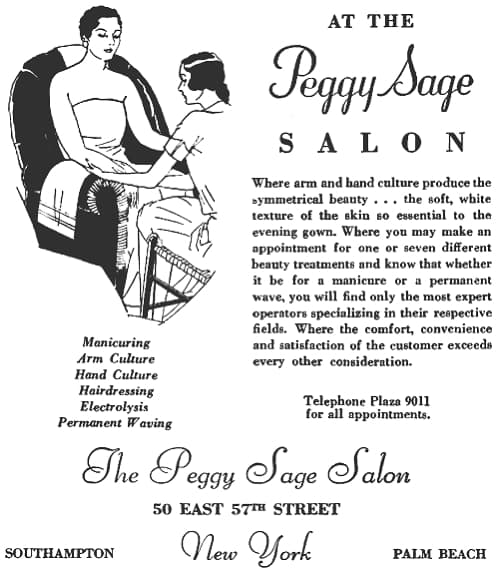
Above: 1929 Peggy Sage salon services.
By 1929, Peggy Sage had also opened salons at Palm Beach, Southampton and East Hampton. Her name was so well known by then that she was mentioned in one of the many advertisements Palmolive ran at the time featuring famous beauty experts.
The 1929 stock market crash may have been the reason behind Peggy Sage incorporating her business as Peggy Sage, Inc. in 1930. This allowed Northam Warren – the makers of Cutex, America’s largest selling nail polish at the time – to take a substantial interest in the firm and Peggy Sage became part of the Northam Warren group which included Cutex, Elcaya, Odorono, and Glazo. Peggy Sage appears to have had no problems with this new arrangement.
See also: Northam Warren, Cutex and Odorono
Expansion
Manicure products do not appear to have had the same slump in sales suffered by many other cosmetics during the Great Depression and Peggy Sage continued to do well during the 1930s despite the bad economic conditions.
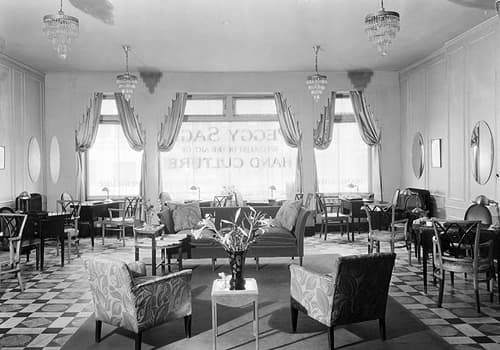
Above: 1934 Peggy Sage Salon at 50 East 57th Street, New York (Museum of the City of New York).
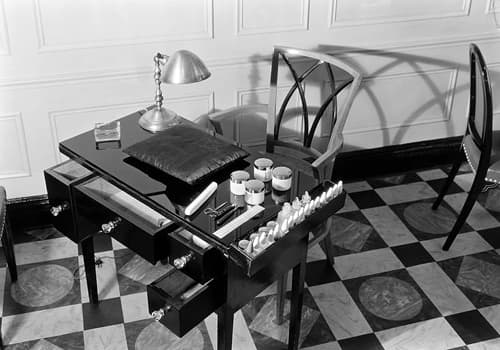
Above: 1934 Manicure desk in the New York Salon (Museum of the City of New York).
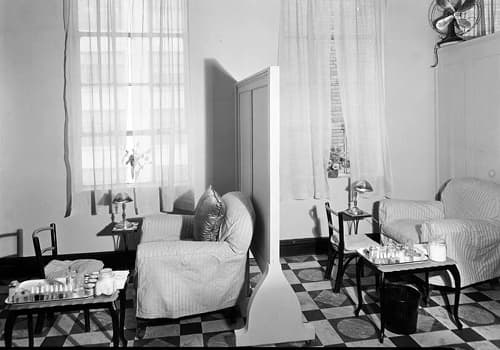
Above: 1934 Pedicure cubicles in the New York Salon (Museum of the City of New York).
In addition to sales in American and Canadian department stores and specialty shops, Peggy Sage also became available overseas. A London salon was opened at 130 New Bond Street in June, 1934 with a Paris salon was established the following year at 7 Place Vendôme. Cutex was already being sold in these markets and Northam Warren wanted Peggy Sage there as well.
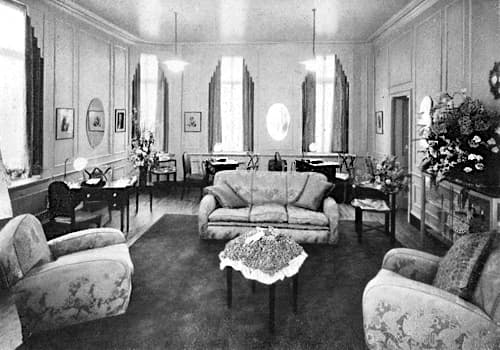
Above: 1935 Peggy Sage Salon at 130 New Bond Street, London.
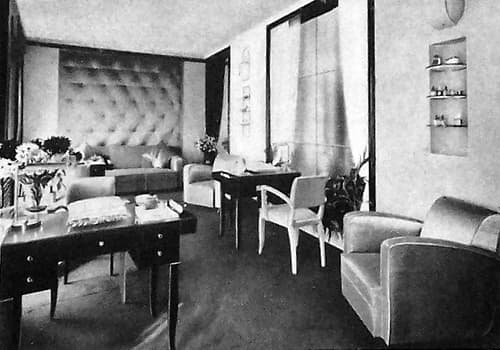
Above: 1939 Peggy Sage Salon at 7 Place Vendôme, Paris.
By the end of the decade, the company had outlets in places such as Lausanne, Switzerland; Rio de Janeiro, Brazil; Buenos Aires, Argentina; Budapest, Hungary; Stockholm, Sweden; Singapore; and Melbourne, Australia.
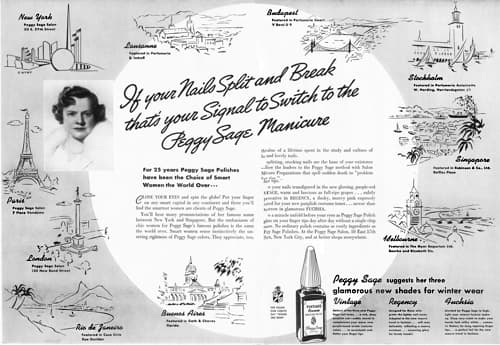
Above: 1939 Peggy Sage outlets worldwide.
Unfortunately, 1932 also saw the arrival of Revlon, a company that would prove to be Peggy Sage’s most aggressive competitor. Revlon sold its products through department stores but its business in the 1930s was ‘salon-oriented’. A salon manicure allowed clients to try a Revlon nail enamel and this often resulted in a sale and a longer-term change of brand. Unlike Cutex, Peggy Sage was not widely available in salons and this put it at a severe disadvantage. The company widened its salon distribution in 1938 but by then Revlon was firmly entrenched.
See also: Revlon
Nail polish
Peggy Sage is sometime said to have introduced red nail polish into the United States and there may be some truth to this. Florence Wall [1893-1988] suggests that this occurred in 1916 when Peggy Sage added colour to its nail lacquers.
In 1916, Peggy Sage introduced a whole Battery of delicate shades of lacquer for the nails. The idea immediately became popular.
(Wall, 1972, p. 119)
Peggy Sage relates a story that describes why she did this and puts the event in a similar time period.
It all began, says Miss Sage, some 20 years ago,when an opera singer called at her salon to pose a special problem. She had lovely fluid hands, but she feared they were wasted on her public.
It occured to Miss Sage that if hands were made up—accented with color—just as the face was, they could be seen farther across the footlights. So she mixed a little stain with a natural liquid polish to make the first pale carmen lacquer. As the star was singing “Carmen,” it was an appropriate debut for the carmen nails.
They were a sensation. Fashionable women came to Miss Sage to ask for especially blended polishes. There were cries of protest, too, of course. “But see what it has done for women’s hands,” cries Miss Sage. “Women have become hand conscious. They spend time on developing pleasing, graceful hands and the results are very evident.”(‘Long Island Daily Press,’ August 18, 1938, p. 6)
It is tempting to believe this tale but it seems more likely that Peggy Sage was following a European trend for coloured nails, something her well-traveled clients would have observed in salons in London or Paris, or on the beaches of Deauville and the French Riviera.
Also see: Nail Polishes/Enamels
The shades of Rose Petal Nail Enamel sold by Peggy Sage up to 1930 are sketchy at best. As well as the near colourless Pale, and Extra Pale shades, Peggy Sage also sold polishes with a pink tint including Rose Coral, Medium, and Dark. These polishes were translucent, with the colour coming from dyes/stains so they differed from the opaque (cream) forms made with pigments more commonly employed today. Peggy Sage polishes also came in Jewel Shades that could be matched with jewellery – such as Onyx, White Pearl, Rose Pearl, Silver, Sapphire Blue, Amethyst, and Jade Green.
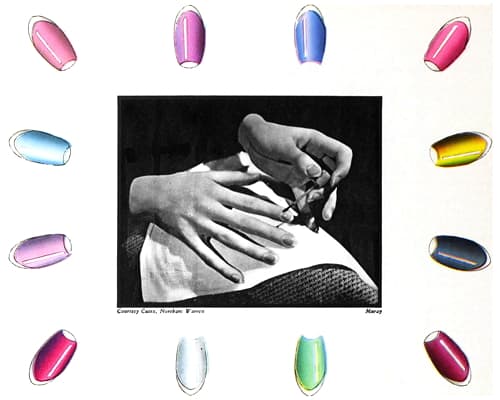
Above: 1930 Peggy Sage Nail Enamel shades.
In 1930, Peggy Sage launched a set of vivid red nail polishes with colours matched to lipsticks – Palm Beach Coral, Biarritz Red, and Lido Crimson, with Blood Red following later in the year. Peggy Sage was not the only American company to add deeper reds to nail polishes in 1930. Cutex did the same introducing Coral, Cardinal, and Garnet shades in that year as did Glazo, another Northam Warren nail polish brand.
See also: Glazo
Peggy Sage advertisements promoting these new colours in 1930 also include lipsticks. However, sales may have been short lived as there is no further mention of them until they reappear in 1947.
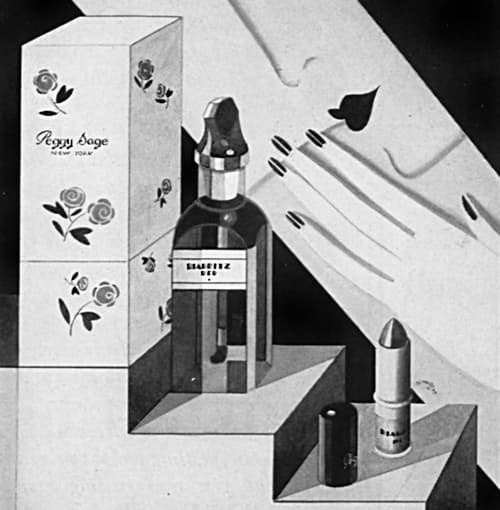
Above: 1930 Peggy Sage Biarritz Red Nail Polish and Lipstick.
The naming of the first three Peggy Sage deep red shades suggests a possible reason for their introduction – the widespread adoption of suntanning by the fashionable elites. Pale polishes and lipsticks looked anaemic against darker skin tones and women sporting a fashionable tan looked for deeper shades of powder, lipstick and nail polish to wear during the summer months.
Society women had long been applying nail polishes when going to the beach and Peggy Sage advertisements stressed that her nail polishes would be unaffected by bathing.
Rose Petal Nail Enamel has become the recognized leader for women of culture and refinement. A polish that is impervious to fresh or salt water—a polish that glorifies the hand.
(Peggy Sage advertisement, 1927)
Those who did not want to wait for their skin to tan before using a deeper shade could apply Peggy Sage Sham-Tan introduced in 1933.
Sham-Tan: “Sun or no sun, take your ‘sunburn’ to the beach in a jar, spread it over your skin evenly, and have that ‘all summer at the beach’ look instantly! Salt water won’t affect Peggy Sage’s product, but warm water and soap remove it.’ Shades: Light Tan, and Dark Tan.
Many women still preferred clear or lighter shades of nail polish and there were occasions where a pale polish was preferable as, for example, when wearing pastels.
Other polish shades introduced by Peggy Sage through the decade included: Pink Coral (1931); Oxblood, Diane Red, Fire Engine Red, Tomato Red, and Chinese Red (1933); Mahogany (1934); Rust, Topaz, Cyclamen, and Imperial Red (1935); Tulip, Dusty Rose, Red Banana, Bisque, and Shrimp (1936); Wisteria, Whitepetal, Hacienda, Clover, Thistle, Nasturtium, Pimento, Swampfire, Cyclamen Pink, and Fiesta (1937); Vintage, and Regency (1938); and Heartbreak, Nosegay, Goldrush, Sari, Fez, Mantilla, Applecart, Fuchsia, and Wicked White (1939).
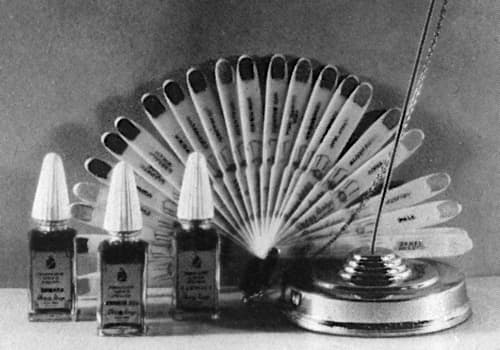
Above: 1935 Fan of Peggy Sage Nail Enamel shades.
It is difficult to know which shades were still translucent but it seems likely that, by 1935, most were opaque, cream polishes of the kind that Revlon advocated.
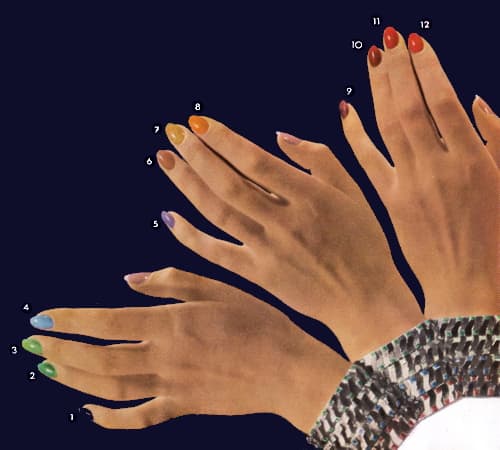
Above: 1935 Votre Beauté, a French beauty magazine, gives the Peggy Sage equivalents for the listed shades: 1. Onyx; 2. Emerald Green; 3. Jade Green; 4. (None); 5. Violet; 6. Bronze; 7. Pearl Gold; 8. Topaz; 9. Imperial Red; 10. Oxblood; 11. Chinese Red; and 12. Tomato Red. Note: All appear to be cream shades and cover the entire nail plate.
These were toned with costume colours and Peggy Sage provided clients with shade charts to help them with their selection.
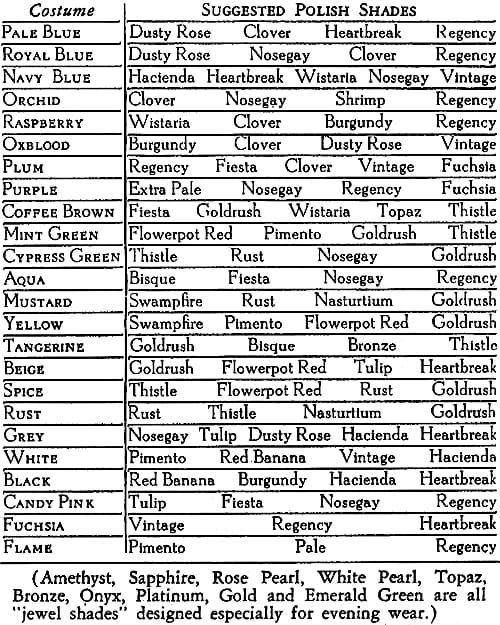
Above: c.1939 Suggested polish shades for different costumes.
The way Peggy Sage applied nail polish also changed through the decade. In 1935, Peggy Sage manicurists were recommending leaving the half moon clear and the free edge white but by 1937 this had changed to covering the whole nail plate with polish from half moon to tip, a practice also recommended by Revlon.
Other products
Peggy Sage also sold a range of other manicure products including a wide range of manicure kits. In the 1920s these cosmetics included: Cuticle Oil, Cuticle Cream, and Cuticle Remover for treating the cuticle; Nail Rouge Paste, Nail Powder, and Nail White for polishing the nail plate and whitening the free edge; Nicotine Remover to remove stains; and an assortment of hand creams and lotions – Velvet Hand Lotion (in Rose or Violet fragrance), Pearl Cream Liquid Powder, and Hand Massage Cream. Also on offer was a Face Powder and Peggy Sage Perfume.
New manicure products introduced during the 1930s included: Lubricant Polish Remover (1934), Nail Dress (1936), and Satinbase (1938).
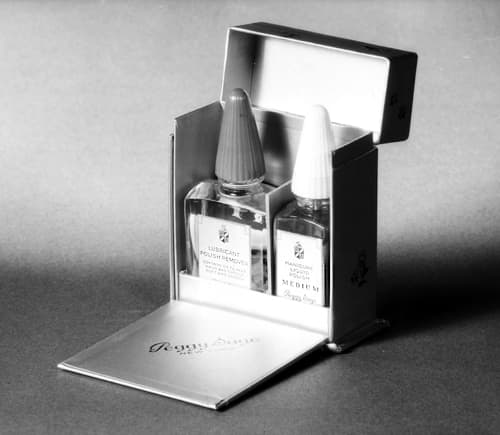
Above: 1934 Lubricant Polish Remover (left) and Medium Liquid Polish (right).
Lubricant Polish Remover: “Contains oil to keep nails and cuticle soft and smooth.”
Nail Dress: “[A] soapy preparation containing softening and nourishing oils. Used regularly, it will keep the cuticle soft and well-groomed and help to prevent nail brittleness.”
Satinbase: “[A] waxy base that protects the nails and makes your polish last longer. It fills out the ridges and makes your polish flow on evenly . . . [It] may be left on indefinitely, but your polish remover will take it off when your polish requires repairing.”
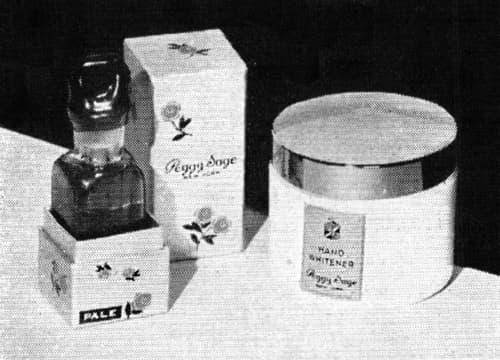
Above: 1932 Peggy Sage Pale Nail Polish and Hand Whitener Cream.
Peggy Sage also updated her hand creams and lotions in the 1930s. By 1935, she was selling Hand Smoother and Softener Cream, Hand Whitener Cream, and Hand Mask Cream along with the older Hand Massage Cream, later adding Gardenia Liquid Hand Cream (1936) and Hand Lotion Bouquet (1939).
Hand-Smoother and Softener Cream: “[Use] this rich cream each night before retiring. It helps to replenish natural oils and fights coarseness and wrinkles.”
Hand-Whitener Cream: “This is a ‘dress up’ cream. … [C]lients love the exquisite white effect it gives the hands. an it is perfect for the arms, shoulders and ankles in the evening. Spread it on evenly and work it gently into the skin.”
Hand-Mask Cream: “It is recommended for dry, coarse skin and wrinkles. Smooth on … during the day, leave it on for five to ten minutes then remove with a soft cloth or tissues.”
Gardenia Liquid Hand Cream: “This rich, creamy lotion protects the skin from summer sun and winter’s biting winds.”
Hand Lotion Bouquet: “This clear, rose colored lotion is not the least bit sticky. … It smoothes the hands immediately and leaves a delicate fragrance.”
The recommended 1939 Peggy Sage home manicure routine was therefore as follows:
1. Remove Polish with Peggy Sage Lubricant Polish Remover. Hold the moistened cotton in contact with the nail for a few seconds, then smooth firmly toward the nail tip.
2. File nails to oval shape with emery board. Do not file too closely at sides. This may cause hangnails.
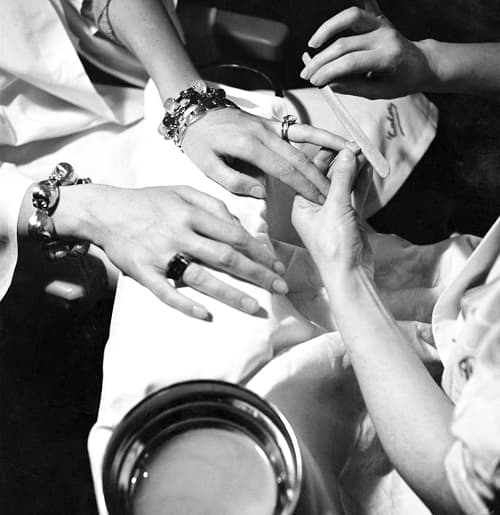
Above: Client having their nails filed with an emery board.
3. Remove any stains from ink, nicotine, vegetables, and gardening with Peggy Sage Nicotine Remover.
4. Buff nails in one direction only, using Peggy Sage Powder Polish and Buffer.
5. Apply Peggy Sage’s Nail Dress around the nail and cuticle with finger tips. (This gentle cream contains fine nourishing and softening oils.) Immerse hands in water.
6. Apply Lubricant Cuticle Remover with orange stick wrapped in cotton. This contains a new oil ingredient for smoothing and softening cuticle.
Push cuticle back and work under nail tips gently. Wipe away loosened cuticle with a towel.
7. Apply Nail White (pencil or paste) under tips. Scrub nails thoroughly and dry.
8. Wipe each nail with Lubricant Polish Remover with light, quick strokes to assure a dry smooth surface for polish.
9. Apply Peggy Sage Satinbase in a thin coating over the entire nail. This helps strengthen nails. Or if applied over the polish instead of under, the Satinbase increases the wear considerably.
10. Apply the New Peggy Sage Liquid Polish. Use enough polish on the brush so that it flows onto the nail smoothly but without running down into the cuticle. First outline the half-moon with one light stroke across the nail. Then complete the covering with two or three quick strokes from half-moon to tip. With a tissue remove a hair line of polish at nail tip. The new Peggy Sage Polish is dry to the touch in three or four minutes, but it continues to harden underneath for another ten minutes. If you will be careful not to scratch the nails during the first few minutes, this polish will outwear any other polish you have ever used. Beautifully lustrous and sunfast!
11. Apply Peggy Sage Manicure Oil or Cuticle Cream around cuticle and wipe off excess with towel or tissue. Always use oil or cream after applying polish, not before.
12. Smooth Hand Massage Cream over the hands, massaging fingers, hands and wrists.
13. Apply Bouquet Hand Lotion with absorbent cotton to remove excess cream. Pat the hands dry.
Also see the booklets: Beautiful Hands by Peggy Sage (c.1939) and Beautiful Hands by Peggy Sage (c.1940)
Economically the decade seemed to end well for Peggy Sage. The New York salon was redecorated and sales in 1939 were 100 per cent over the previous year.
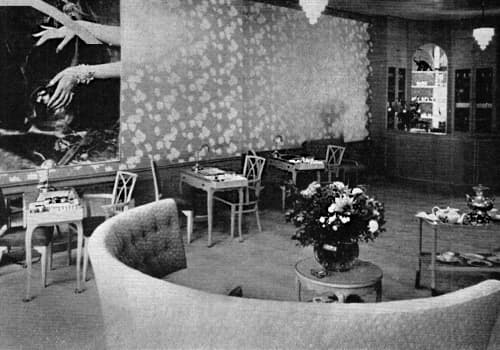
Above: 1939 Peggy Sage New York Salon after refurbishment.
Timeline
| 1917 | Peggy Sage establishes a manicure business. |
| 1920 | Peggy Sage products become available in Canada. |
| 1926 | New York Salon opens at 50 East 57th Street. |
| 1927 | Products now sold in department stores. |
| 1930 | Peggy Sage Incorporates. Northam Warren buys a substantial interest. |
| 1932 | Nail preparations repackaged. New Products: Hand Whitener. |
| 1933 | New Products: Sham-Tan. |
| 1934 | London salon opens at 130 New Bond Street. New Products: Lubricant Polish Remover. |
| 1935 | Paris salon opens at 7 Place Vendôme. |
| 1936 | New Products: Nail Dress; and Gardenia Liquid Hand Cream. |
| 1938 | New Products: Satinbase. |
| 1939 | New York salon redecorated. New Products: Hand Lotion Bouquet. |
Continued onto: Peggy Sage (post 1940)
First Posted: 6th April 2021
Last Update: 21st February 2024
Sources
The American perfumer & essential oil review. (1906-1955). New York: Robbins Perfumer Co. [etc.].
Peggy Sage. (c.1938). Beautiful hands by Peggy Sage [Booklet]. New York: Author.
Wall, F. E. (1972). Historical development of the cosmetics industry. In M. S. Balsam, & E. Sagarin. (Eds.). Cosmetics: Science and technology (2nd ed., Vol. 3). New York: Interscience Publishers, Inc.
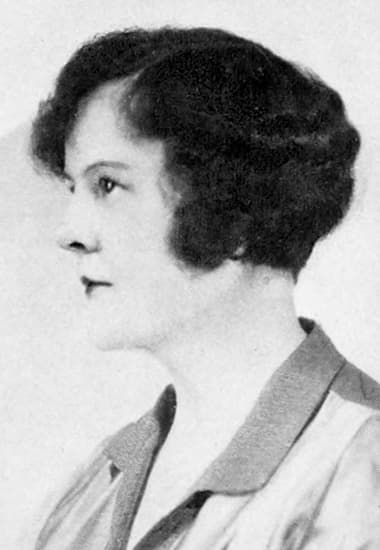
Peggy Sage [1880-1961] a.k.a. Rosabelle Sage, Rosabelle Doody, and Rosella Doody.
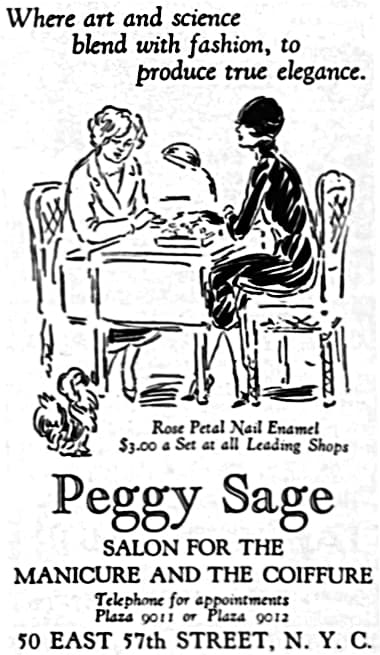
1926 Peggy Sage Rose Petal Nail Enamel.
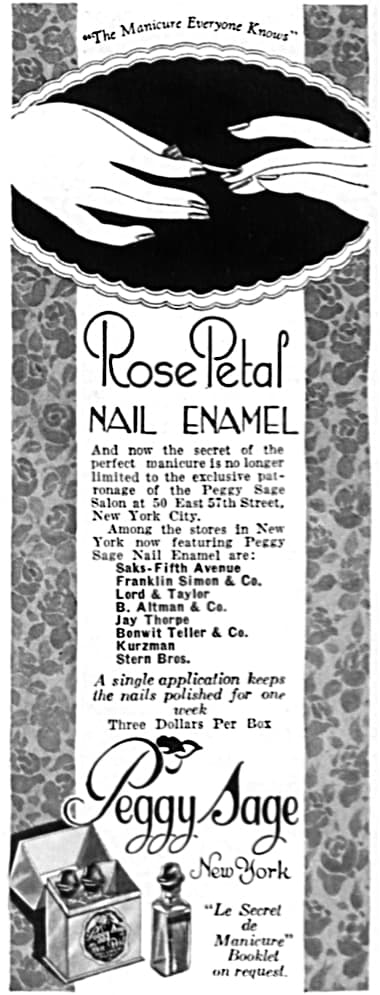
1927 Peggy Sage Rose Petal Nail Enamel.
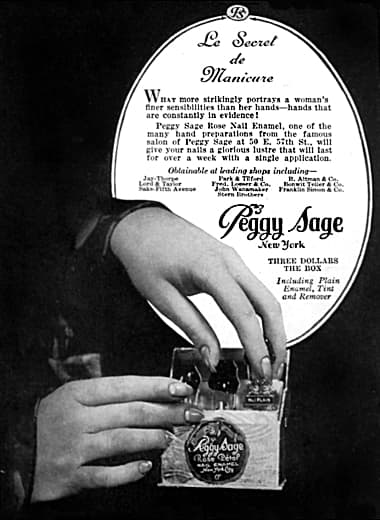
1927 Peggy Sage ‘Le Secret de Manicure’.
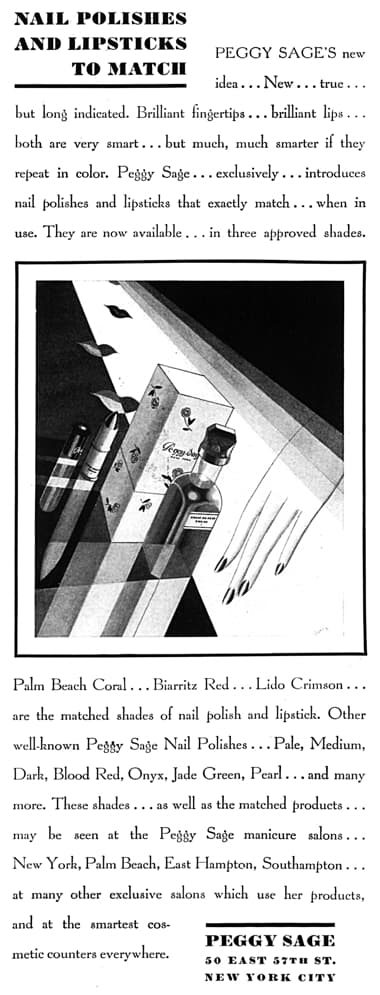
1930 Peggy Sage Nail Polishes and matching Lipsticks.
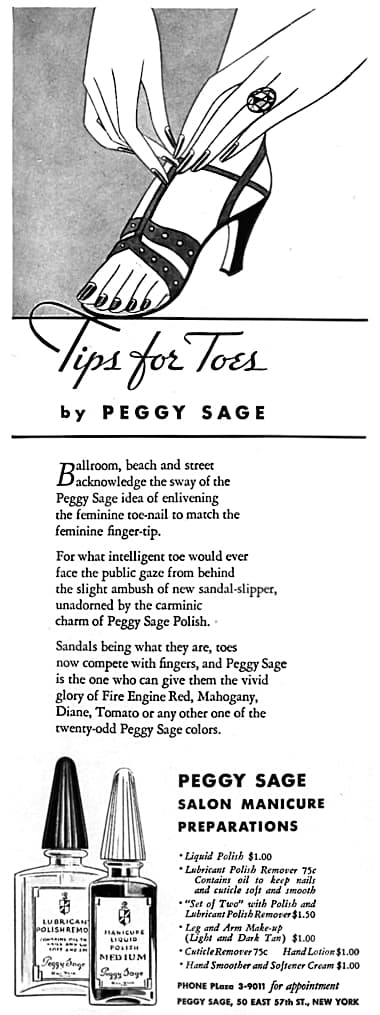
1934 Peggy Sage Tips for Toes.
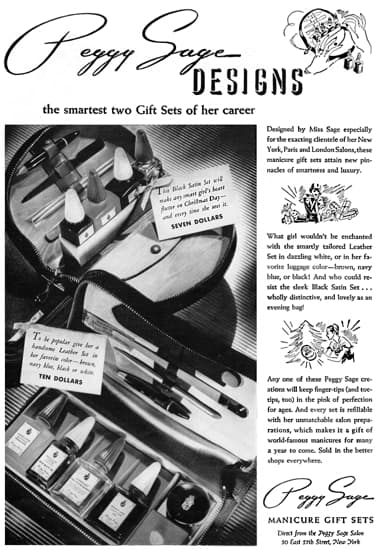
1934 Peggy Sage Manicure Kits.
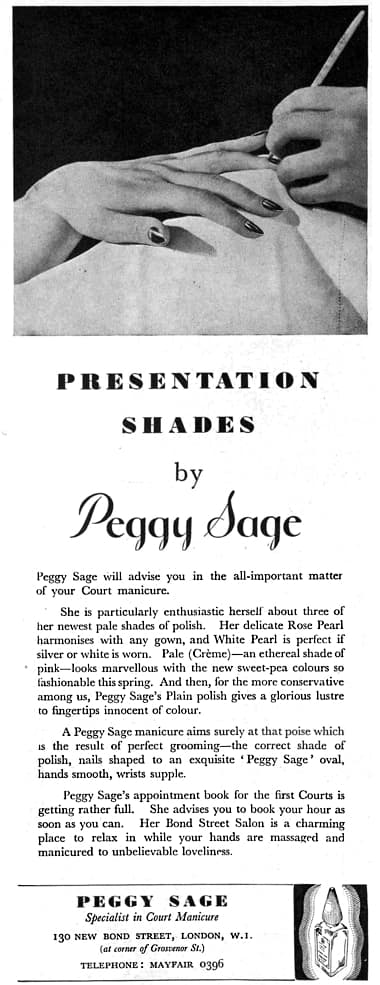
1935 Peggy Sage presentation shades (Britain).
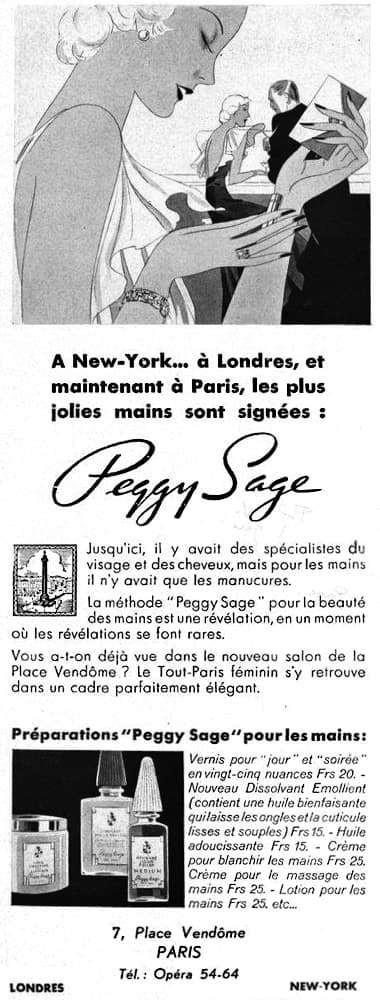
1936 Peggy Sage (France)
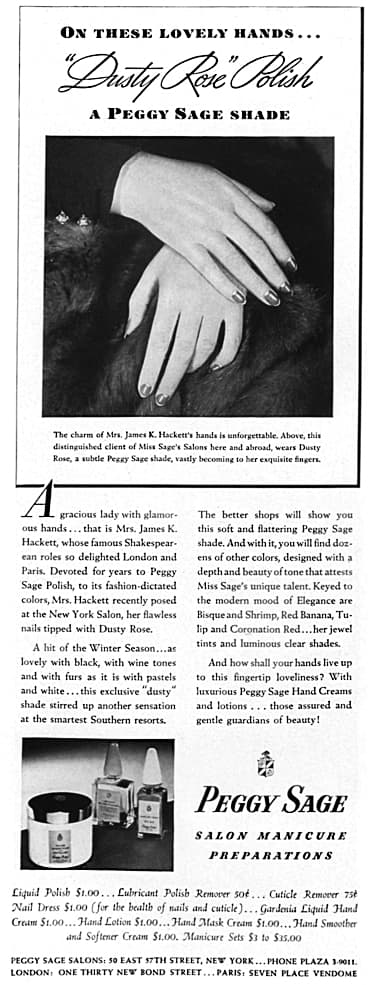
1937 Peggy Sage Dusty Rose.

1937 Peggy Sage shades for the Coronation of George VI matched with hair colour (Britain). The Coronation shade may have only been available there.
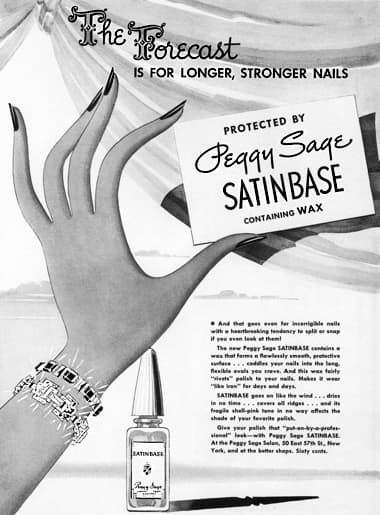
1938 Peggy Sage Satinbase.
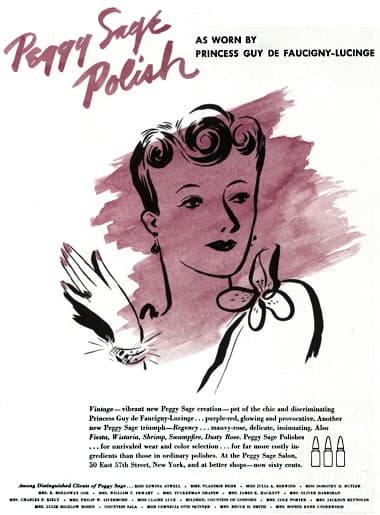
1938 Peggy Sage Vintage Nail Enamel.
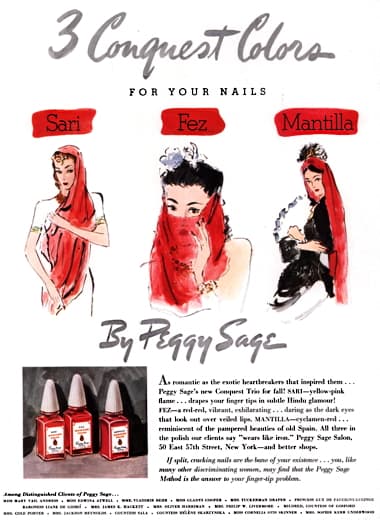
1939 Peggy Sage Sari, Fez, and Mantilla Nail Enamels.
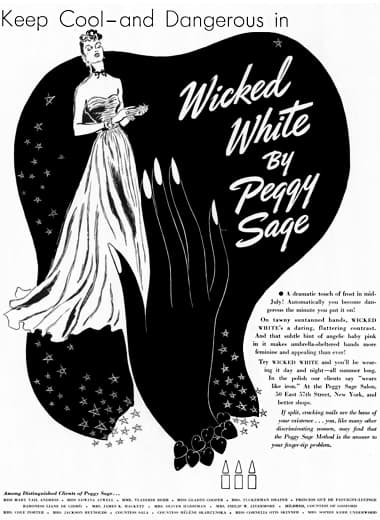
1939 Peggy Sage Wicked White Nail Enamel.
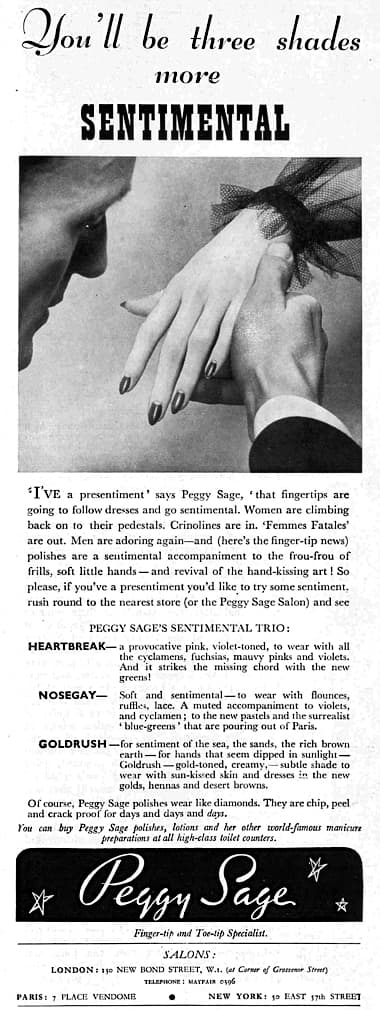
1939 Peggy Sage Sentimental shades (Britain).
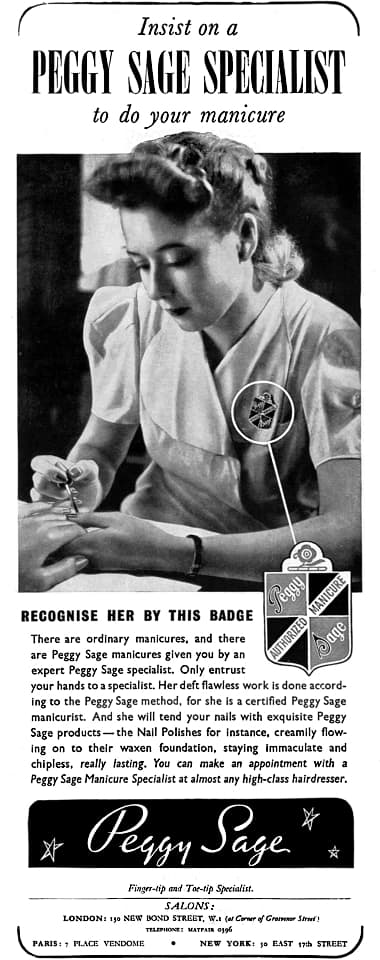
1939 Peggy Sage Manicure (Britain).

1940 Peggy Sage Gymnastics for Hands.
